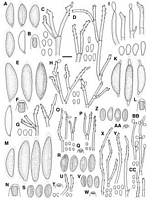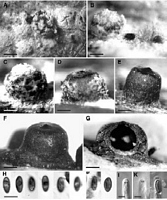|
 Rosellinia johnstonii Rosellinia johnstonii
BiostatusPresent in region - Indigenous. Endemic
Images (click to enlarge)
Caption: Fig. 12 A-D, Rosellinia novae-zelandiae, PDD 43205: A, Ascospores, last one immature; B,
Ascus apical ring; C, Conidiophores and conidia on the host (PDD 16422); D, Conidiophores
and conidia in culture (PDD 42074); E-H< | 
Caption: Fig. 17 Rosellinia johnstonii. A-F, Stromata, A-C, showing subiculum; G, Vertical section of
stroma, outer shell stroma, inner perithecium; H, Ascospores, note asymmetrical plac |
Article: Petrini, L.E. (2003). Rosellinia and related genera in New Zealand. New Zealand Journal of Botany 41(1): 71-138 (http://www.rsnz.org/publish/abstracts.php).
Description: Subiculum evanescent, cream to light brown, with grey patches bearing conidiophores and,
when very young, ascomatal initials can be seen, on some hosts developing under the
epidermis, later erumpent. Stromata (400)563 ± 73(725) µm high, (550)760 ± 91.5(950) µm
wide (n = 85), cylindrical to barrelshaped with flattened, disk-like top, 350-550 µm diam.,
often with discoid base, dark brown to black, shiny, solitary or crowded in small groups,
sometimes 2-3 fused together, young stromata covered by the felty subiculum and
progressively emerging during development until completely free at maturity; sometimes
additionally covered by host epidermis, thus appearing white. Ostioles finely to coarsely
papillate. Ectostroma 50-75(100) µm thick, black. Entostroma initially white, then cream,
brown, absent in mature material. Perithecia detached and collapsed in mature material. Ascus
apical rings (1)2 ± 0.4(2.8) µm high (n = 41), upper width 2.4- 2.8 µm, lower width 1.9-2.8
µm, without bulge at upper margin, J+, pale blue. Ascospores (9.6)12.5 ± 1(16) µm long,
(4.8)6.2 ± 0.6(9) µm wide (n = 385), inequilaterally ellipsoidal, brown to dark brown, with
straight germ slit, typically extended to the entire length of the spore, but often situated closer
at one end than at the other (Fig. 17H). Conidia 3- 4.5 x 2.5-3.5 µm.
Cultures on OA after 20 days at 20°C under diffused daylight with centre slightly raised,
hyphae restricted, margin flat, white, some red pigment spreading, sterile. On CMD under
same conditions, 1.5 cm diam., flat, appressed, without aerial mycelium, centre opaque, waxy,
margin translucent, slightly orange, after 34 days 2 cm diam. After 24 days 2-2.5 cm, centre
flat, compact, grey-green due to fruiting structures, outside loosely cottony, white.
Conidiophores over 200 µm long, 2-3 µm wide, mononematous, unbranched or roughly
dichotomously branched, smooth, subhyaline to pale tan towards base. Conidiogenous cells
cylindrical, terminal and intercalary, geniculate with conspicuous, circular refractive frill at
each point of conidial dehiscence. Conidia 3.5-4.5(6) x 2-3(4) µm (n = 43), subglobose to
elliptical, rarely clavate, with protuberant, flat basal abscission scar bearing a minute frill,
smooth, subhyaline. On PDA white to cream with large grey-brown areas bearing the
conidiophores, felty, forming concentric rings, reverse light brown.
ANAMORPH: Geniculosporium.
Habitat: HOSTS: Agathis australis, Coprosma arborea, Dysoxylon spectabile, Elaeocarpus dentatus,
Nothofagus truncata, Pittosporum umbellatum.
MATRIX: Decorticated heavily decomposed wood, bark.
Notes: ETYMOLOGY: In honour of the New Zealand mycologist P. R. Johnston.
NOTES: Distinctive features of R. johnstonii are the flattened top of the stroma and the
asymmetrical position of the germ slit on the ascospore. It is closer o one spore end and more
distant towards the other (Fig. 17H). The subiculum can be observed only in young material.
At first sight, this species may be confused with Astrocystis spp. However, it clearly belongs
to Rosellinia as young stromata develop in a subiculum and the anamorph belongs to the form
genus Geniculosporium, contrary to Astrocystis, in which the stromata break through the host
epidermis and may split in a stellate manner, and the anamorphs belong to form genus
Acanthodochium (Ju & Rogers 1990; Læssøe & Spooner 1994). The anamorph in culture
differs from the one of R. communis by more frequent intercalary conidiogenous areas having
more loci.
Rosellinia johnstonii also resembles R. mammoidea, but it has smaller, narrowly ellipsoidal
ascospores with an asymmetrical germ slit and larger stromata with flattened discoid-like tops.
The stroma and ascospore sizes are statistically significantly different, as shown by the 65%
confidence ellipses (Fig. 9C) and the discriminant analysis (data not shown). R. subiculata
(Schw.) Sacc. has slightly smaller ascospores than R. johnstonii. These two species also differ
from each other with respect to subiculum, stroma shape, and germ slit (Petrini 1993).
|